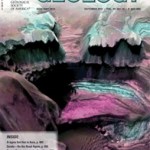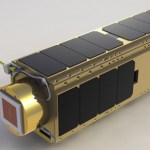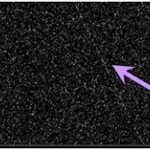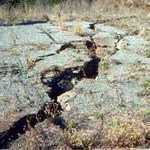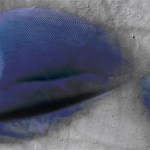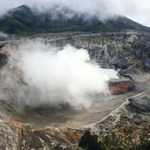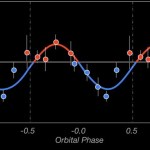
By Dr. Gerry Harp, Senior Astrophysicist, Center for SETI Research, SETI Institute, and Gail Jacobs
Trained as a quantum mechanic, Dr. Gerry Harp was deeply interested in possibilities for using the multiple telescopes of the Allen Telescope Array to generate steerable "beams" on the sky -- beams that could be far smaller than any single antenna could produce. Such beams don't emit anything, but work in reverse by capturing only energy that comes from the sky in a certain direction. Gerry joined the SETI Institute in 2000, practically at the telescope's inception and uses the telescope for…
By Dr. Janice Bishop, Senior Scientist
SETI Institute
October 3, 2011
Two small depressions on Mars found to be rich in minerals formed by water could have been places able to support life relatively recently in the planet's history. These findings were published October 1, 2011, in the journal Geology. The team, led by Catherine Weitz of the Planetary Science Institute, studied layered outcrops at the western region of the huge Valles Marineris canyon system.
Many ancient clay-rich rocks have been found on Mars in recent years. What is interesting about this study at Noctis Labyrinthus is…
By Dr. Richard Quinn; Carl Sagan Center for the Study of Life in the Universe, SETI Institute, and Gail Jacobs
Is the surface of Mars really sterile, or could there be still-undiscovered traces of life littering this hostile landscape? Chemist Richard Quinn focuses on understanding the reactive processes that take place on the surface of the Red Planet, and how these might give a better idea of the potential for habitable environments.
Click on images for larger view
Richard, briefly describe your research projects.
I typically have four to five concurrent projects, all with a common theme,…
By Dr. Gerry Harp, an astrophysicist at the
SETI Institute.
Figure 1: A waterfall plot. This shows the signal as a function of frequency (increasing to the right) and time (increasing to the top). A slanted straight line is just the sort of thing we look for in SETI searches. In this case, it is from the Voyager spacecraft, 100 times further from the sun than is the earth.
You know that feeling where you have a great idea about doing SETI but you don't have a large radio telescope handy when you need it? If so, then we have something for you.
For the past two years, the SETI Institute has…
By Dr. Franck Marchis, SETI Institute
Kepler-16 is another great discovery coming from the Kepler telescope, the 10th NASA Discovery mission which is devoted to finding Earth-size exoplanets by monitoring variations of brightness due to transit. Today the Kepler team found a circumbinary exoplanet, an exoplanet orbiting a binary star system. Did they find Tatooine?
Artistic view of the Kepler-16(AB)b exoplanet (a saturn-like exoplanet) in orbit around its 2 stars in the background.
Image credit: NASA/JPL-Caltech/T. Pyle
In the large 105 deg2 field of view of the Kepler spacecraft, ~156,000…
By Dr. Laurance Doyle, an astrophysicist at the SETI Institute, and lead author of a paper that will appear in the journal Science on September 15, 2011.
For the first time, astronomers with the NASA Kepler spacecraft mission have discovered a planet orbiting two stars. This is a fundamentally different kind of planetary system than has ever been discovered before. The new system is known as "Kepler-16" and consists of two stars -- one about 69% the mass of the Sun, and the other only 20% the mass of the Sun, which circle each other every 41 days. Around both of these circles the Saturn-mass…
By Dr. Rachel Mastrapa; Carl Sagan Center for the Study of Life in the Universe, SETI Institute, and Gail Jacobs
Rachel Mastrapa studies the surface processes of icy Solar System bodies by interpreting their infrared spectra. The majority of her work involves performing the ground truth measurements in the laboratory including calculating the complex indices of refraction of single composition ice samples. These measurements are then used to construct model spectra to interpret the chemical composition of observed spectra. She also studies the subtle changes seen in ice mixtures that are not…
SETI Institute Engages the Public and Celebrates ScienceClick on images for larger view
The cosmos can be mysteriously alluring to all -- from the young in age to the young at heart. In particular, space science and astrobiology fill us with wonder, amazement and awe -- but the scientists who work in these intriguing fields may seem intimidating to the non-scientist. At the SETI Institute, we open our doors on an annual basis and invite the public to celebrate science with us at our Mountain View, California, headquarters in what is always an energizing and informative interactive science…
By Dr. Cynthia Phillips
Planetary geologist at the Carl Sagan Center for the Study of Life in the Universe, SETI Institute
The final mission of Space Shuttle Atlantis has spawned a whole series of perspective pieces on the history, state, and future of space exploration. Some, like the YouTube video "NASA's increase of awesome to continue," are unabashedly exuberant celebrations of the future in store for us in space; others, like this thoughtful piece in Technology Review entitled "Was the Space Shuttle a Mistake?," are depressingly and effectively critical of the cost both in dollars (more…
By Dr. Friedemann Freund; Carl Sagan Center for the Study of Life in the Universe, SETI Institute, and Gail Jacobs
Friedemann Freund doesn't shrink from taking on the really big problems. His research has elucidated such important phenomena as the fact that rocks under stress behave like batteries that can produce currents deep within the crust of the Earth. These are not piddling electron flows, either - the currents could be as large as millions of amperes, sufficient to be measured above ground, and perhaps even from orbit. Understanding and exploiting this phenomenon could lead to a…
By Dr. Janice Bishop; Carl Sagan Center for the Study of Life in the Universe, SETI Institute, and Gail Jacobs
Dr. Janice Bishop is a chemist and planetary scientist who explores the planet Mars using spectroscopy. Her investigations of CRISM data of Mars are revealing clays and sulfates in the ancient rocks that provide information about the geochemical environment at that time. Dr. Bishop studies the spectral fingerprints of minerals and rocks in the lab in order to generate a spectral library for identification of these in the Martian data. Her research also involves collecting and…
Today, NASA announced three future key missions preselected as part of the Discovery program named GEMS, TiME and Comet Hopper. This is an important announcement, which was eagerly expected by our community.
The NASA Discovery program is a low-cost mission ($425 million FY2010) program aimed at developing and supporting a well-defined and narrow-range science mission in the field of planetary exploration. Discovery is a dynamic and highly valuable program which had led to a lot of well-known missions with a wide range of scientific goals including (adapted from Visions & Voyages Decadal…
By Dr. Lori Fenton; Carl Sagan Center for the Study of Life in the Universe, SETI Institute, and Gail Jacobs
Planetary scientist Dr. Lori Fenton joined the SETI Institute's Carl Sagan Center as a Principal Investigator in 2006, and was awarded NASA's Carl Sagan Fellowship for Early Career Researchers that same year. Lori's primary research interests include aeolian geomorphology - how wind shapes a planetary surface - for both Mars and the Earth, recent and ongoing climate changes, and the mobility of wind-blown sand and dust. Her research makes use of many different types of information,…
By Dr. Mark Showalter
Senior Research Scientist at the Carl Sagan Center for the Study of Life in the Universe, SETI Institute
Four and a half billion years ago, a fluffy "snowball" coalesced out of the cloud of ice, dust and debris still surrounding our Sun. Most of the snowballs like it later merged to become the planets we know. This one, however, had a chance flyby with a young planet, probably Jupiter. Jupiter's gravity propelled it out into the far reaches of the Solar System, where it remained in deep freeze, among many others like it, as a member of the so-called Oort cloud.…
By Dr. Jon Jenkins; Carl Sagan Center for the Study of Life in the Universe, SETI Institute, and Gail Jacobs
Dr. Jon Jenkins of the SETI Institute is the Analysis Lead for NASA's Kepler Mission. He heads up a group of about two-dozen scientists and programmers who designed and built the software that is the brains behind this dramatic search for other worlds. With a photometric precision of 20 parts per million, Kepler is able to discover planets that are the same size as the rocky, inner orbs of our own solar system. By making an inventory of such worlds, Kepler will answer one of the most…
Remembering Dr. Emma Bakes
An exceptional person, Dr. Emma Bakes passed away on February 28, 2011. She accomplished a great deal and touched many people in an unfortunately short time. Her accomplishments span oceans and included the physical sciences, medicine, fashion, martial arts, and parenthood to name just a few. To honor and remember her, the SETI Institute and NASA's Kepler Mission Team invite you to read the following essay she wrote just a few months ago. It is an essay that reflects her life and her legacy...
Donald Mendoza, NASA Ames, and the SETI Institute
The Shore of the Cosmic…
By Dr. Ignacio Mosqueira, an astrophysicist at the Carl Sagan Center for the Study of Life in the Universe, SETI Institute, and Gail Jacobs
Ignacio Mosqueira works with Paul Estrada to piece together the way in which giant planets - such as Jupiter and Saturn -- and their moons and rings formed. Ignacio notes that making moons is similar to forming planets. Understanding moons may have something to tell us about the possible habitats for life, since large moons could, in principle, have both the liquid water and atmosphere necessary for the kind of diverse biology we see on planet Earth.…
By Franck Marchis
There will be a before and after Kepler Era in astronomy. Today, with the release of 1,202 exoplanet candidates from data collected with the Kepler spacecraft over 140 days of observation, we have just entered in a new age of astronomy.
The Kepler spacecraft is the 10th NASA Discovery mission launched in March 2009 which was designed to search for exoplanets by measuring almost continuously the brightness of 156,453 stars in a small 12 degree diameter patch of the sky. The 0.95m-telescope is able to detect attenuation of the host star located in the Cygnus, Lyra, Draco…
By Dr. Darlene Lim, a geobiologist and limnologist at the Carl Sagan Center for the Study of Life in the Universe, SETI Institute, and Gail Jacobs
Dr. Darlene Lim's research interests span Earth and Space Science. She conducts limnological and paleolimnological investigations of remote lakes and ponds in the Canadian High Arctic to characterize Holocene climate change. She has also extrapolated her Arctic work to Mars analog paleolake reconstructions. Darlene led the establishment of the Pavilion Lake Research Project in 2004 and has enjoyed managing and evolving the project ever since. She…
By Dr. Franck Marchis
Astronomer at the Carl Sagan Center for the Study of Life in the Universe, SETI Institute
It is done. The Kepler team finally announced the discovery of its first terrestrial exoplanet. A referred journal, accepted in the Astrophysical Journal by Natalie Batalha and a large number of colleagues, describes this new member of the exoplanet family. This is the 519th known exoplanet based on the Extra-solar Planets Catalog, but definitely a special one.
Skychart showing the position of KIC 11904151, a faint (11th magnitude in visible) sun-like star located at 172 pc in the…

